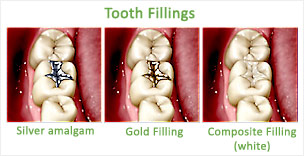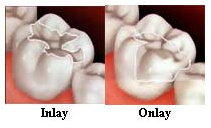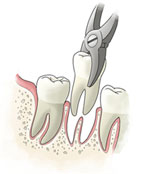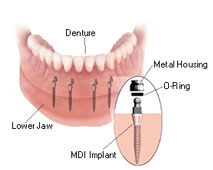Fillings / Restorations - Tooth Fillings
If your tooth becomes damaged through an accident, the action of bacteria and acid or erosion of the enamel, a filling (or restoration) is used to replace the damaged or missing part of the tooth. This can restore the tooth to natural appearance and function and is one of the most common forms of dental treatment.
There are very few people over 20 years old that have no fillings in their teeth. Many of the "Baby Boom" generation had large fillings in all of their back teeth (molars) by the time they turned 20. Although this is an improvement on the previous generation, who often had all their teeth removed and replaced with dentures; it does mean that most of us regularly need fillings replaced even if no further damage has occurred to a tooth.
There are several types of fillings, each does a different job and some are better suited to certain teeth than others. The 4 main types of filling are:

Inlays and Onlays :

Inlays and Onlays can be made of porcelain, gold, or composite resin. These pieces are bonded to the damaged area of the tooth. An inlay, which is similar to a filling, is used inside the cusp tips of the tooth. An Onlay is a more substantial reconstruction, similar to the inlay but extending out over one or more of the cusps of the tooth.
Root Canals:
A root canal is one of the most common dental procedures performed, well over 14 million every year. This simple treatment can save your natural teeth and prevent the need of dental implants or bridges.
At the center of your tooth is pulp. Pulp is a collection of blood vessels that helps to build the surrounding tooth. Infection of the pulp can be caused by trauma to the tooth, deep decay, cracks and chips, or repeated dental procedures. Symptoms of the infection can be identified as visible injury or swelling of the tooth, sensitivity to temperature or pain in the tooth and gums.

Tooth Extractions :

Some teeth are extracted because they are severely decayed; others may have advanced periodontal disease, or have broken in a way that cannot be repaired. Other teeth may need removal because they are poorly positioned in the mouth (such as impacted teeth), or in preparation for orthodontic treatment.
The removal of a single tooth can lead to problems related to your chewing ability, problems with your jaw joint, and shifting teeth, which can have a major impact on your dental Health.
Crowns :
Most dentistry looks like dentistry. Our goal is to provide dentistry that is undetectable. We replace existing crowns and fillings with restorations that look and feel like your natural teeth.
Where damage to a person's teeth is extreme, and apparently beyond repair, porcelain crowns can be used to restore a tooth. Crowns are an individually tailored dental restoration which provides an effective way to return functionality and aesthetics to a badly damaged tooth. Crowns are fixed prosthetic devices, meaning they are cemented onto existing teeth or implants, and can only be removed by a dentist. Through new technologies, the shape and colour of the restoration can be matched perfectly to your existing teeth.
Tooth Extractions :
A bridge - a device used to replace missing teeth - attaches artificial teeth to adjacent natural teeth, called abutment teeth. Bridges are either permanently attached (fixed bridges), or they can be removable. Functional bite.

Dentures :
A denture, also known as false teeth, is an appliance that is inserted in the mouth, replaces missing natural teeth using the soft tissues such as the gum ridges and palate for support. Dentures can be either complete or partial. Complete dentures are made for those who have lost all of their teeth, whereas partial dentures are used to replace only a few teeth. They can be constructed with acrylic or with metal; plastic dentures are the budget option, while metal dentures are thinner and more firmly clipped on to other teeth. Dentists can fabricate dentures that fit comfortably, appear natural and help improve your smile. An immediate denture is fabricated and inserted immediately after the teeth are extracted and the tissues are allowed to heal under the denture.


